Create vibrant natural soaps by infusing dried herbs and flowers into your carrier oils or water bases. You'll get stunning yellows from calendula, purples from alkanet root, and blues from butterfly pea powder. For best results, dry your botanicals at 95-115°F and store them in airtight containers away from light. Combine different plant materials and use proper layering techniques to achieve unique color combinations. The world of botanical soap making offers endless creative possibilities to explore.
Essential Herbs for Natural Soap Coloring
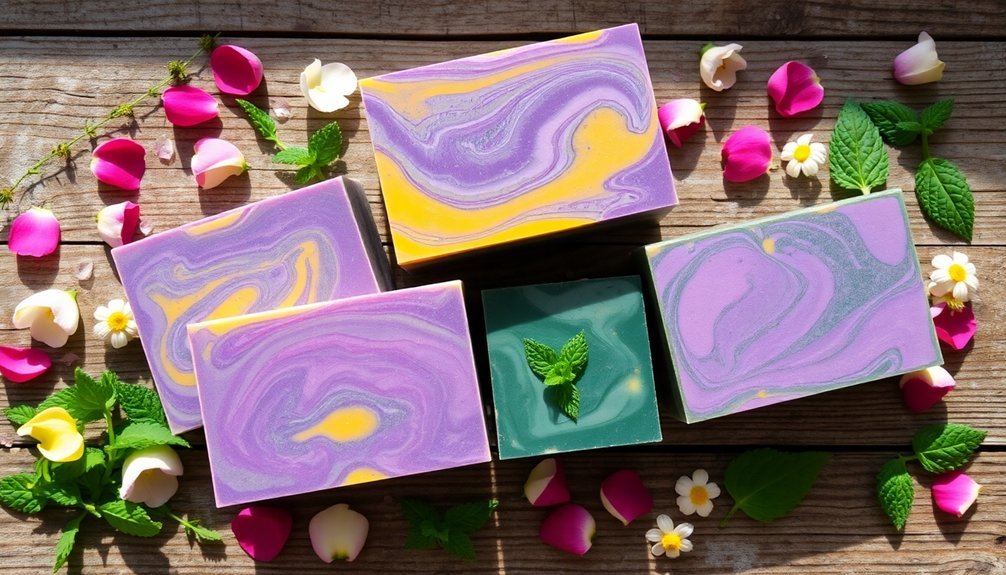
While synthetic dyes might seem like an easy choice, natural herbs offer a stunning array of colors for your handmade soaps.
You'll find calendula flowers particularly reliable, producing vibrant yellows that remain stable even in high pH soap. For your soap recipes, you can also explore alkanet root, which creates stunning purples and pinks during saponification.
To get the best natural color from dried herbs, you'll want to infuse oils with your chosen plants before adding them to your soap. This method prevents browning and enhances color intensity, especially when working with delicate flowers.
For green shades, try spirulina or spinach, though you'll need to store these soaps away from light to prevent fading. Goldenrod and carrot puree offer additional yellow options, while chamomile consistently delivers beautiful golden tones in your herbs for coloring arsenal.
Best Flowering Plants for Soap Pigmentation
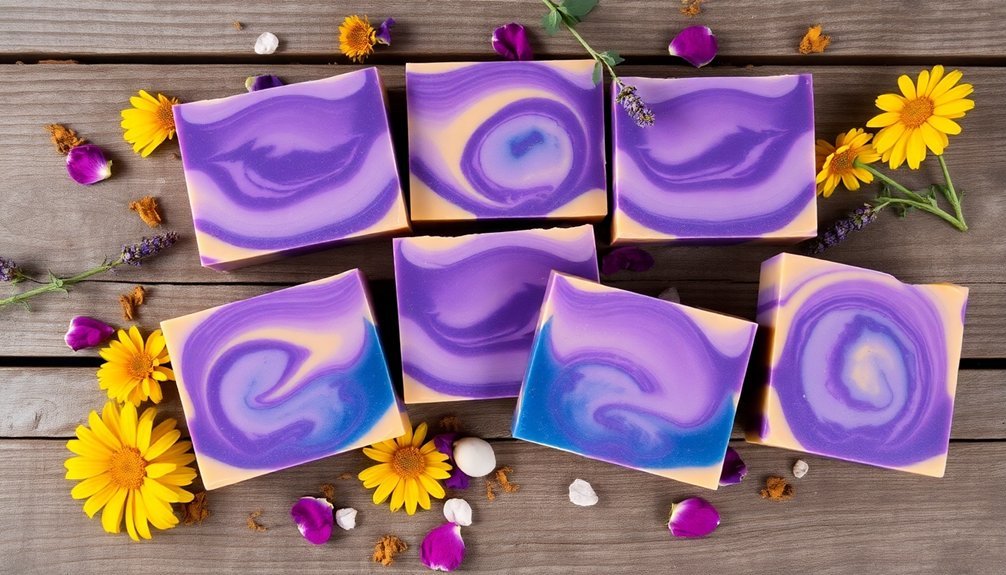
When crafting naturally pigmented soaps, flowering plants offer some of the most reliable and vibrant color options available. You'll find that calendula petals are particularly effective, maintaining their bright hues even in soap's high pH environment.
For stunning pinks and purples, try incorporating alkanet root into your soap recipes – it creates fascinating color transformations during saponification.
If you're seeking natural colorants with specific shades, butterfly pea powder delivers beautiful blues that can shift to purple, while goldenrod and chamomile flowers provide rich yellow tones.
These flowering plants aren't just decorative; they're powerful tools for soap pigmentation. You can enhance their color-giving properties by infusing them into oils before adding them to your soap mixture, ensuring the most vibrant results in your finished products.
Proper Drying Techniques for Botanical Additives
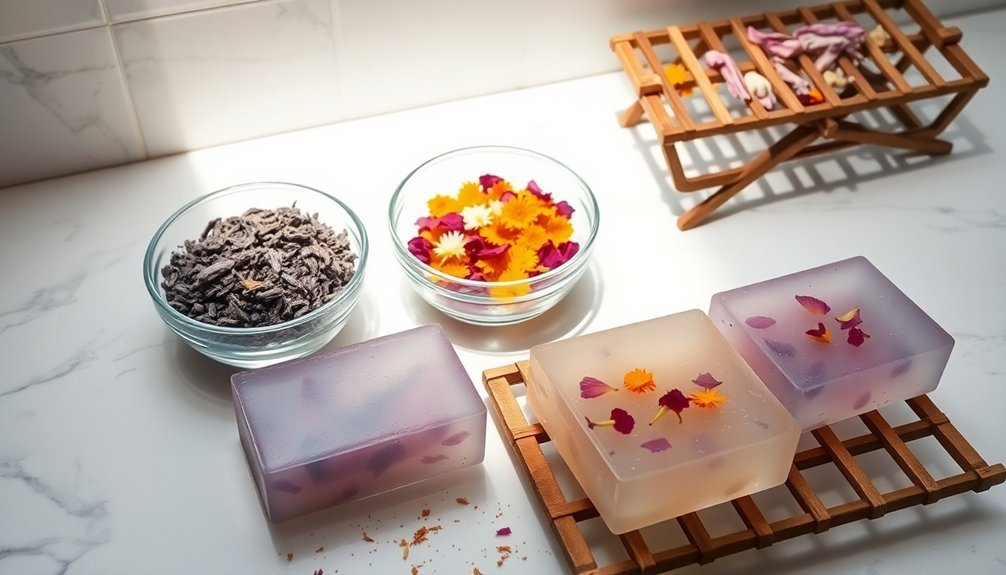
Your drying room should maintain consistent airflow and low humidity, with temperatures between 95-115°F (35-46°C) to properly preserve botanical additives for soap making.
You'll need a food dehydrator or well-ventilated space where you can spread flowers and herbs in single layers, ensuring they're completely dried before processing.
Store your dried botanicals in airtight containers away from direct sunlight and moisture, checking periodically for any signs of deterioration to maintain their vibrant colors and beneficial properties for up to six months.
Optimal Drying Room Conditions
Creating vibrant soaps with botanical additives requires precise drying conditions to maintain the quality and appearance of your natural ingredients.
For ideal drying room conditions, maintain temperatures between 70-80°F (21-27°C) and keep the humidity level at 30-50%. You'll want to guarantee adequate air circulation by using a fan or setting up proper ventilation, which helps prevent mold and promotes even drying of your herbs and flowers.
To preserve color integrity in your dried botanicals, minimize light exposure, as direct sunlight can fade colors and degrade essential oils.
Spread your plants in a single layer on drying racks or screens to prevent moisture-trapping clumps. Monitor your botanicals regularly throughout the drying process, which typically takes between a few days to two weeks, depending on your specific plants and environment.
Air Flow and Temperature
Proper air flow and temperature control serve as the cornerstones of successfully drying botanical additives for soap making.
You'll need to maintain temperatures between 70°F and 90°F to preserve the vibrant colors and fragrances of your herbs and flowers while they dry.
To guarantee ideal air flow, spread your botanical materials in a single layer on a clean, dry surface. You can use a food dehydrator or select a well-ventilated area with low humidity to speed up the process.
Don't forget to check your drying botanicals regularly – they'll typically be ready within one to three days.
Once your herbs and flowers are completely dry, store them in airtight containers away from direct sunlight.
This careful storage will keep their colors and scents intact for your future soap-making projects.
Botanical Storage Best Practices
While botanical additives bring natural beauty to handmade soaps, successful storage begins with thorough drying techniques. To prevent mold and spoilage, you'll need to guarantee complete dryness before storing your dried flowers and herbs.
Lay them flat in a well-ventilated space or use a dehydrator until they're crisp to the touch.
Store dried botanicals properly by following these essential practices:
- Use dark glass, airtight containers to protect against light damage and preserve essential oils
- Keep containers in a cool, dry place away from moisture and direct sunlight
- Check materials for crispness before storage to confirm they're thoroughly dried
- Label each container with the botanical name and drying date to track freshness
With proper storage, your dried additives will maintain their vibrancy and potency for up to six months.
Oil-Based Plant Infusions for Soap Making
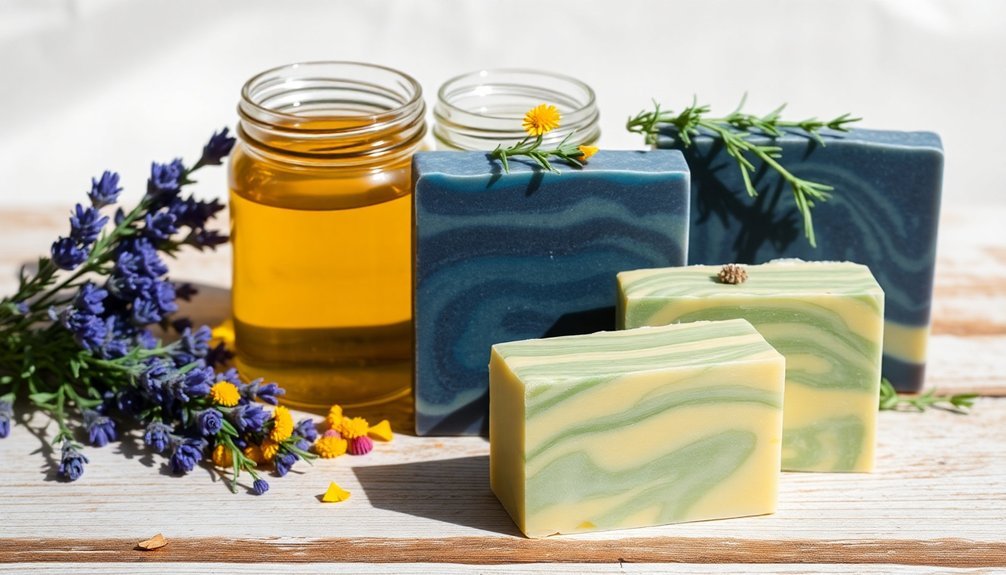
Oil-based plant infusions serve as an essential foundation for crafting vibrant, naturally-colored soaps.
You'll want to start by combining 1 ounce of dried plant material with 1 cup of carrier oil, allowing several weeks for the infusion process to develop full potency. This patience pays off when you incorporate these infused oils into your natural soap recipes.
When you're selecting botanicals for your infusions, consider calendula flowers, which retain their beautiful color and offer notable therapeutic benefits in the final product.
You can substitute a portion of your recipe's regular oils with these infused oils to enhance both color and skin-nourishing properties.
While infused oils contribute subtle natural fragrances to your soaps, you'll likely need to add essential oils if you're seeking stronger scent profiles.
Water-Based Herb Extraction Methods
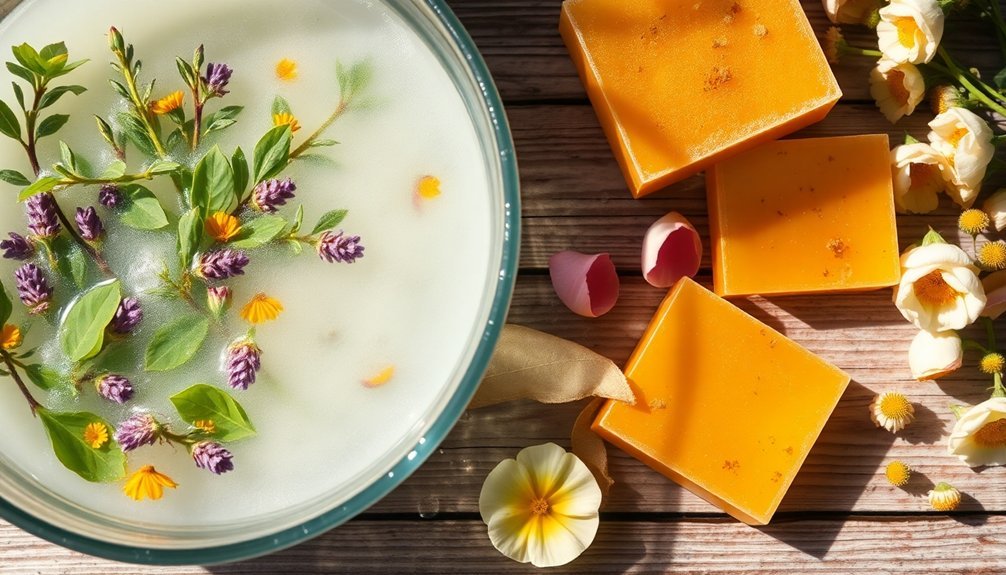
You'll find water-based herb extractions offer three distinct methods to release natural colors and properties from dried botanicals.
Start with hot infusion by pouring boiling water over herbs and steeping for 30 minutes, try cold infusion by soaking herbs in room temperature water for 24 hours, or experiment with solar infusion by placing your herb-water mixture in sunlight for 4-6 hours.
These techniques let you create vibrant, skin-nourishing extracts that you can incorporate into your soap recipes at room temperature.
Hot Infusion Process Steps
Creating vibrant herbal infusions for your soap begins with a simple yet effective hot water extraction method. The hot infusion process transforms dried herbs into a potent liquid that you'll use to replace water in your soap recipes, adding both color and therapeutic benefits to your final product.
Follow these essential steps for a successful herbal infusion:
- Measure your ingredients using a 1:2 ratio – one ounce of dried herbs for every two cups of water
- Heat water until it's just below boiling, then add your dried herbs
- Allow the mixture to steep for 30 minutes to 2 hours, stirring occasionally to maximize extraction
- Strain the infusion through a fine mesh sieve or cheesecloth to remove all plant material
Remember to use only dried herbs, as fresh ones can introduce unwanted moisture that may compromise your soap's quality.
Cold Infusion Steeping Methods
While hot infusions offer quick results, cold steeping provides a gentler approach to extracting colors and properties from dried herbs.
You'll need to combine 1 cup of dried herbs with 4 cups of water, letting them soak for 24 to 48 hours to extract their therapeutic properties.
When preparing your cold infusion, always use dried herbs to minimize mold growth and prevent spoilage.
After the steeping period, strain the mixture thoroughly to remove all plant material.
You'll be left with a colored liquid that's perfect for your soap recipes.
The cold infusion method yields subtle hues that won't overpower your final product, making it ideal for creating delicate color variations.
Since water-based extracts are lighter than oil infusions, they're excellent for achieving gentle, natural-looking tones in your handmade soaps.
Solar Infusion Techniques
Solar infusion represents one of the most energy-efficient methods for extracting colors and beneficial properties from dried herbs and flowers.
This gentle technique harnesses the sun's warmth to draw out essential oils, natural color, and therapeutic benefits from plant materials without using artificial heat sources.
You'll need to follow these key steps for successful solar infusion:
- Select your dried herbs carefully, avoiding fresh plants that can cause unwanted moisture and mold
- Fill a clear glass jar with your chosen dried herbs and cover completely with water or oil
- Place the sealed jar in direct sunlight for 1-4 weeks, shaking occasionally to mix
- Strain the liquid thoroughly before incorporating it into your soap making process
This method creates vibrant, naturally-infused liquids perfect for crafting unique, plant-enriched soaps with lasting color and beneficial properties.
Preventing Botanical Discoloration in Soap
Because botanical additives can quickly turn from vibrant to brown in handmade soaps, you'll need to take specific precautions to maintain their natural colors.
Start by avoiding direct mixing of dried flowers into your soap batter, as moisture absorption during saponification leads to discoloration. Instead, consider using calendula flowers, which maintain their vibrant hue when properly infused into oils.
For preventing discoloration in botanical decorations, wait until your soap has fully cured before adding any dried flowers or herbs.
When you're ready to decorate, secure the botanicals using witch hazel or isopropyl alcohol rather than water. Store your finished soaps in a cool, dry environment, and don't insulate them after adding decorative elements.
Remember to use skin-safe essential oils at recommended rates to avoid both irritation and unwanted color changes.
Seasonal Plant Selection and Storage
Spring gardens offer abundant options for soap making, with calendula, lavender, and chamomile reaching their peak vibrancy during this season.
You'll want to harvest these botanicals when they're fully mature and showing their most intense colors for the best results in your soap creations.
Store your dried flowers and herbs in airtight containers away from light and moisture, using them within six months to maintain their vivid hues and aromatic properties.
Best Spring Garden Plants
Three essential categories of plants make for an ideal spring garden when you're planning to create vibrant, natural soaps: flowering herbs, aromatic plants, and colorful blooms.
Your homemade soap will benefit from fresh plant material that's both vibrant and beautiful while offering therapeutic benefits.
Consider these spring garden favorites to decorate your soap:
- Calendula flower petals, which maintain their golden hue and provide gentle skin-soothing properties
- Chamomile and marigolds, perfect for their color stability in soap making
- Rosemary and thyme, adding both visual interest and aromatherapeutic value
- Mint varieties, offering invigorating scents and natural coloring options
Remember to harvest your plants regularly and dry them properly in airtight containers.
This practice guarantees you'll have quality ingredients for soap making throughout the year while maintaining their vibrant characteristics.
Proper Botanical Storage Methods
When selecting botanicals for soap making, proper storage methods become essential for maintaining their vibrant qualities and therapeutic benefits throughout the seasons.
You'll want to use fresh herbs quickly or dry them to prevent spoilage. For dried herbs and flowers, store them in an airtight container in a cool, dark place for up to six months.
To enhance your proper botanical storage methods, consider vacuum sealing your dried materials. This technique helps prevent moisture absorption and preserves their therapeutic properties longer.
Don't forget to label your containers with the drying date and plant type to track freshness. Regularly check your stored botanicals for signs of mold or deterioration.
If you notice any concerning changes, discard them immediately to guarantee your soap-making ingredients remain safe and effective.
Layering Techniques With Natural Colorants
Creating stunning layered soaps with natural colorants requires both artistic vision and technical precision.
You'll discover that these visually stunning effects come from carefully timing each pour and selecting the right plant-based ingredients for vibrant hues.
When working with natural colorants, remember these essential steps:
- Let each layer partially set before adding the next to maintain distinct separation
- Test your colorants first, as pH levels can affect their final appearance
- Consider adding dried flowers between layers for enhanced texture
- Monitor temperature carefully to prevent unwanted mixing
You can achieve beautiful yellows with carrot puree, rich purples using alkanet root, and gorgeous greens with spirulina.
These layering techniques work best when you're patient and methodical, allowing each section to reach the right consistency before proceeding with your next pour.
Combining Multiple Plant Pigments
Building on your layering skills, you'll find that combining multiple plant pigments opens up an exciting world of color possibilities in soap making.
You'll discover that natural dyeing with plant materials like alkanet root and calendula can create vibrant orange hues when properly mixed.
To guarantee color stability, you'll want to infuse your plant materials in oils before adding them to your soap batter. This step is essential for maintaining the vibrancy throughout the saponification process.
Infusing natural colorants in oils first protects their vibrancy, ensuring your soap's beautiful hues survive the saponification journey.
When experimenting with combinations, start with small test batches – mix carrot puree for yellow tones and spirulina for green shades to create unique colors.
Remember that combining multiple plant pigments can lead to unexpected results, so document your successful ratios. This methodical approach will help you develop a reliable palette of natural color combinations that won't brown or fade over time.
Testing Color Stability in Soap Batches
Testing color stability marks an essential step in natural soap making, as plant-based pigments can behave unpredictably during saponification.
You'll need to create small soap batches with different plant-based colorants to understand how they perform over time. Document findings carefully, noting the exact ratios and color changes that occur during the curing process.
- Record which colorants maintain their vibrancy throughout saponification
- Test light-sensitive colorants separately, especially plant-derived blues and greens
- Note any color shifts or fading that occurs over several weeks
- Track successful combinations for future reference
When working with plant-based colorants, remember that exposure to high pH levels can greatly impact their stability.
You'll want to monitor your soap batches regularly, as some colors may take weeks to reveal their true staying power.
Safe Botanical Usage Rates and Guidelines
While botanical ingredients can enhance your soap's visual appeal and therapeutic properties, following proper usage rates guarantees both safety and effectiveness.
When working with dried flowers in cold process soap, use them within six months and incorporate ½ to 1 teaspoon per pound of soap to maintain their vibrant appearance.
Essential oils require special attention in your soaping oils mixture. Keep their concentration between 0.5% and 5% of your total recipe weight to prevent skin irritation.
Essential oils pack potent power – keep concentrations at 0.5-5% of total soap weight to ensure skin-safe formulations.
If you're using fresh botanical additives, choose smaller pieces or puree them to minimize spoilage risks.
Before selling your creations, conduct a safety assessment and verify all ingredients are properly listed on your labels.
These guidelines will help you create beautiful, safe soaps while maintaining compliance with product regulations.
Frequently Asked Questions
How Do You Make Vibrant Colors in Soap?
You'll achieve vibrant soap colors by using natural plant sources like carrot puree for yellow, alkanet root for purple, and calendula petals for orange. Store your soaps away from light and infuse oils with botanicals.
What Flowers Are Good for Soap Making?
You'll get the best results using calendula, cornflowers, chamomile, goldenrod, lavender, and roses. Calendula's especially great as it keeps its vibrant color, while chamomile maintains its white and yellow hues nicely.
What Flowers Don't Turn Brown in Soap?
You'll find that calendula, chamomile, and marigold petals keep their vibrant colors in soap without browning. Dried herbs like mint, rosemary, and thyme also maintain their natural hues during the soap-making process.
How to Make Soap With Flowers?
Use dried flowers instead of fresh ones to prevent browning. You'll want to sprinkle them on top or mix finely ground petals into your soap batter. Calendula petals work especially well for maintaining vibrant colors.
In Summary
You'll find that creating vibrant soaps with natural botanicals opens up endless creative possibilities. Whether you're working with deeply-hued herbs, bright flower petals, or colorful root infusions, remember to test your combinations and respect safe usage rates. Don't be afraid to experiment with different extraction methods and layering techniques. With practice, you'll master the art of transforming nature's palette into stunning handmade soaps.

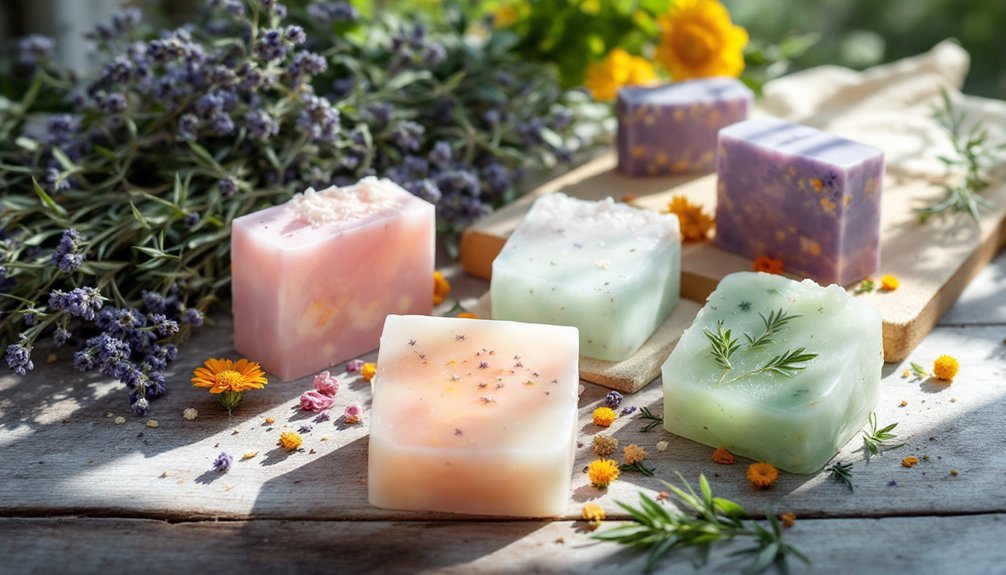



Leave a Reply